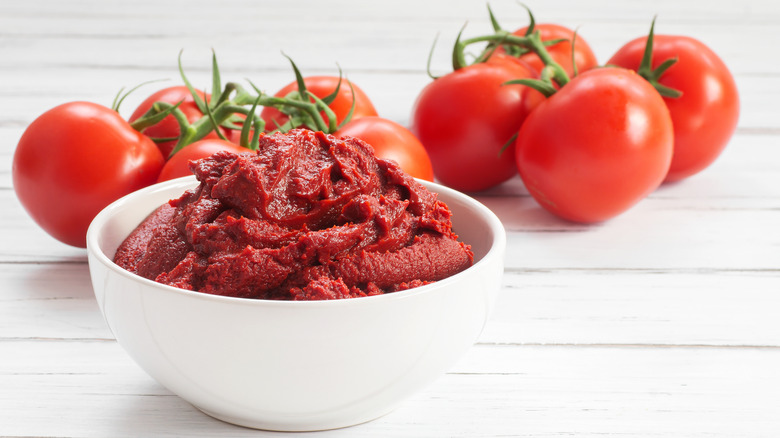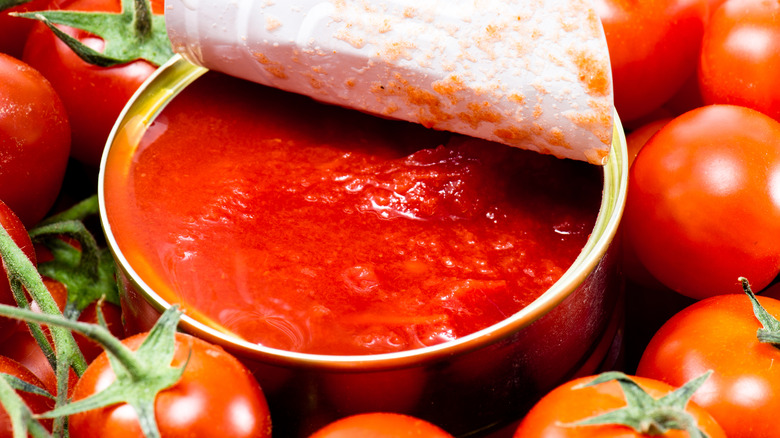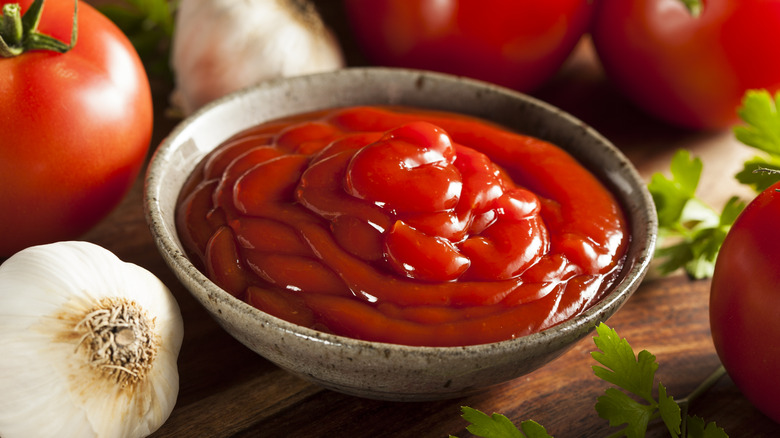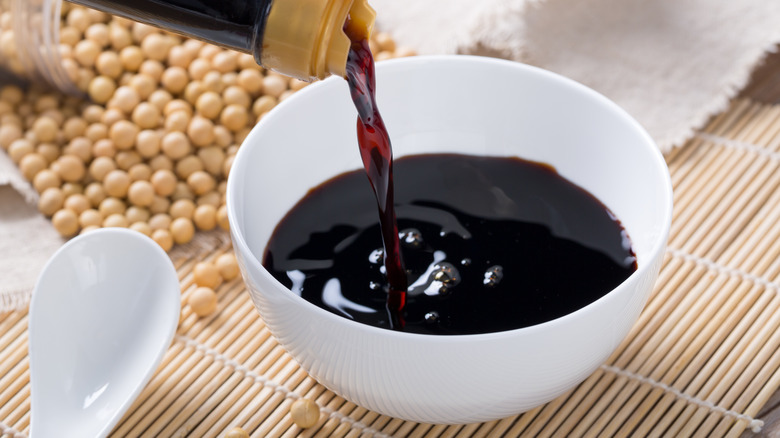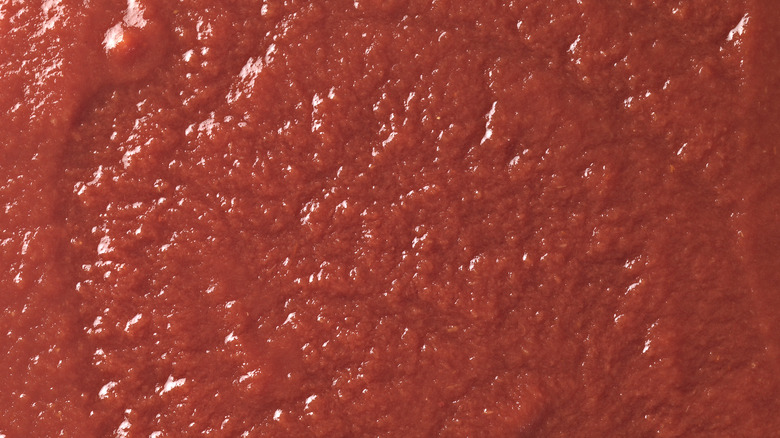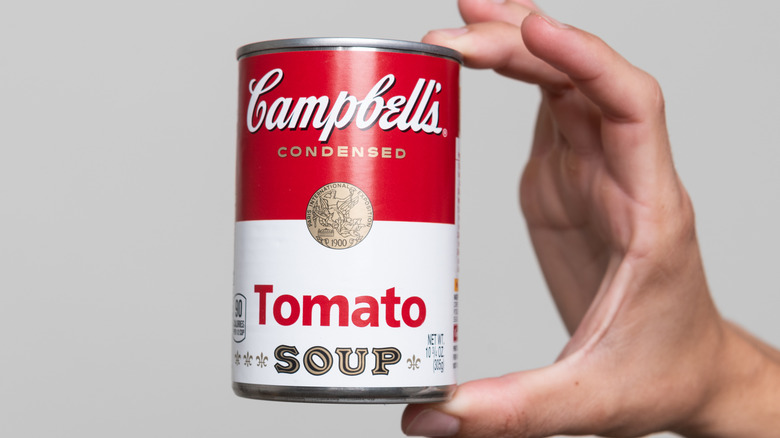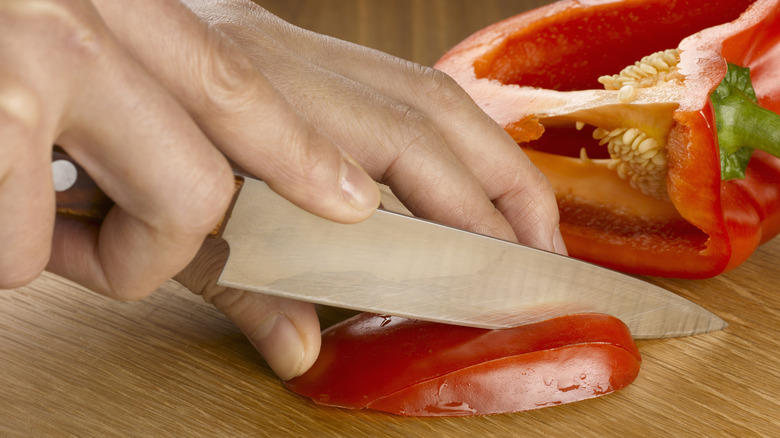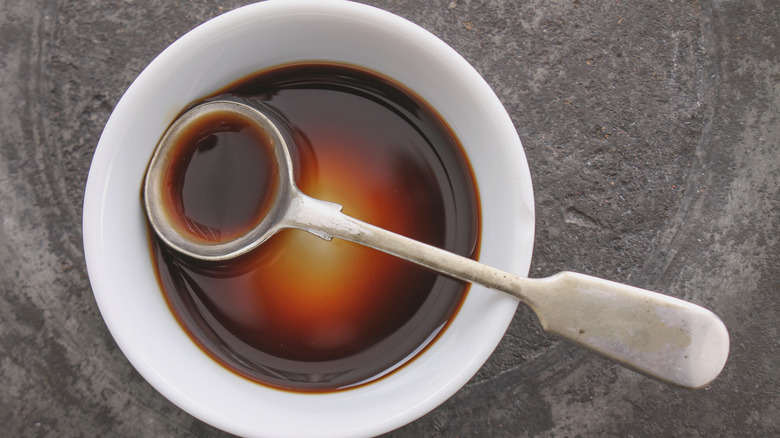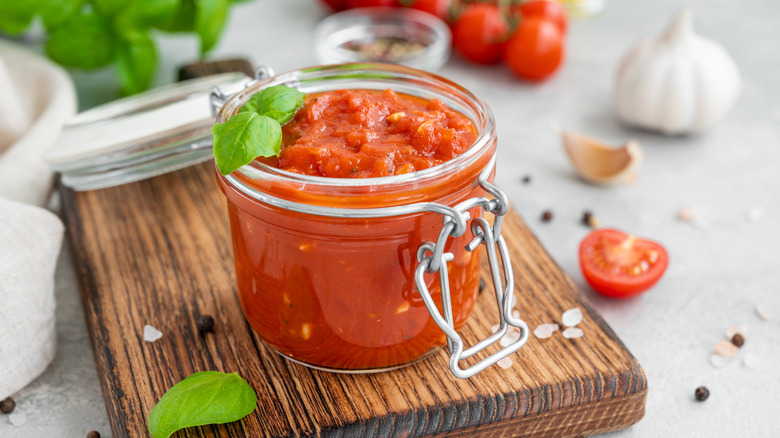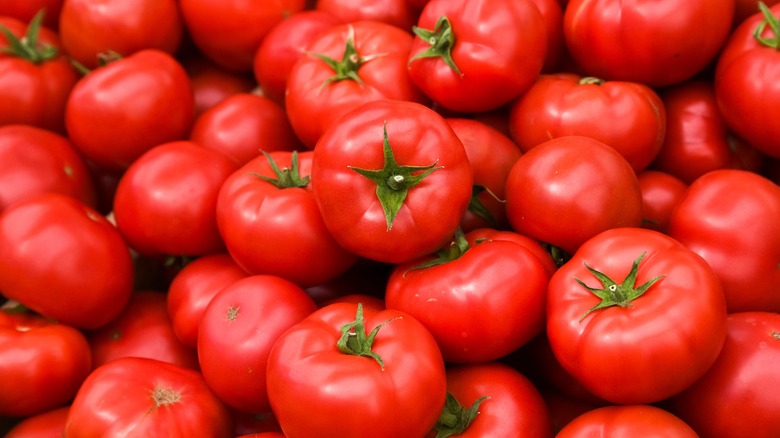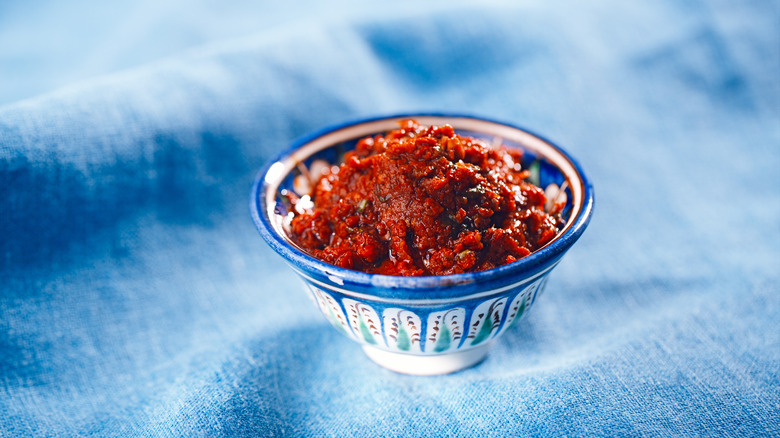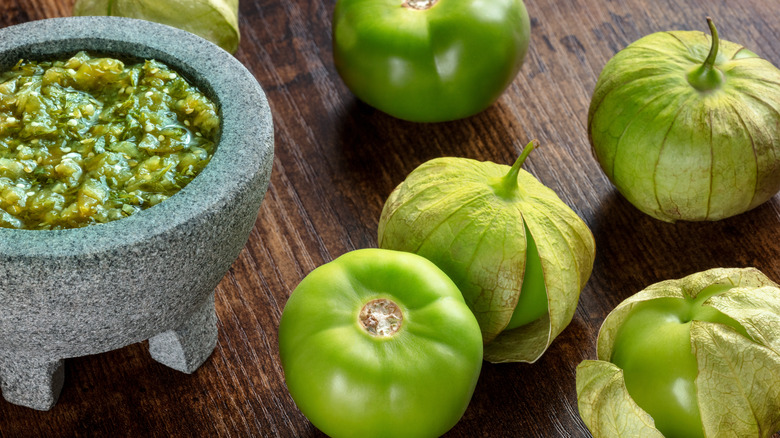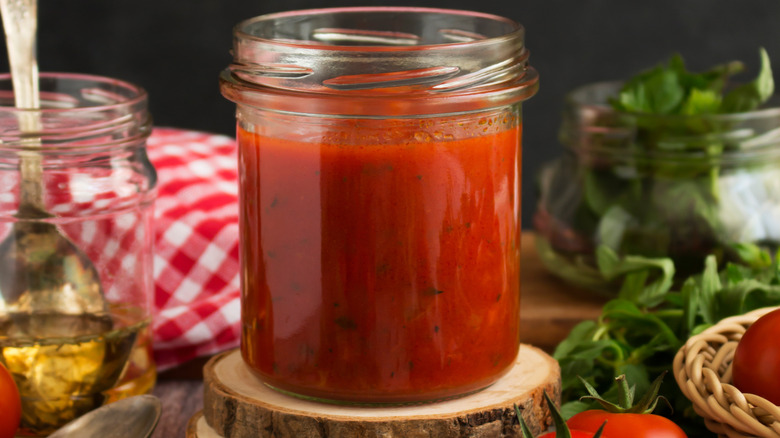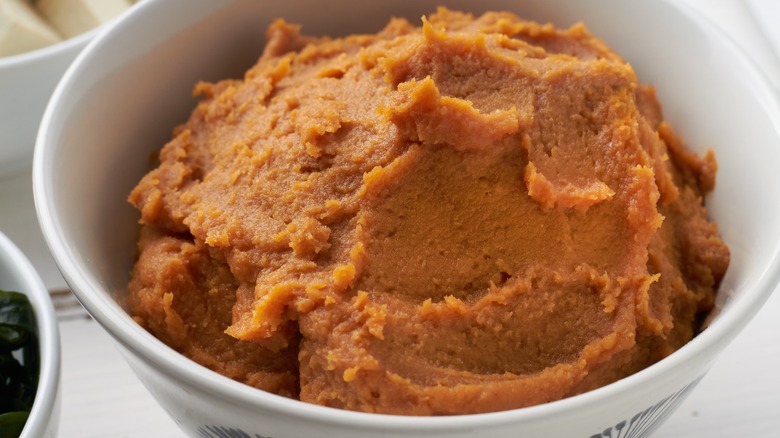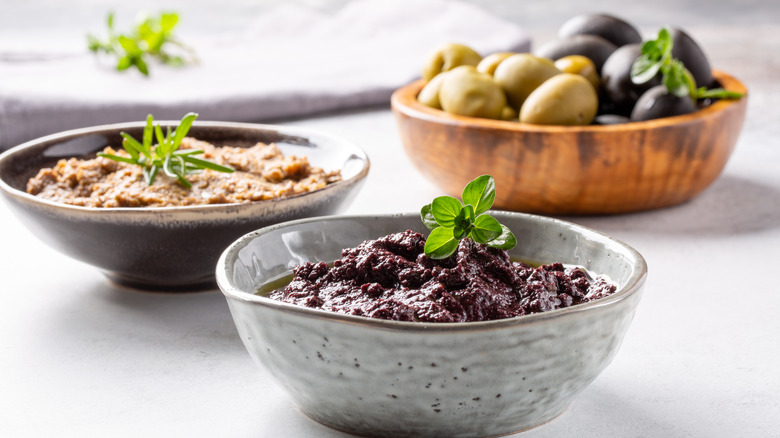If You Run Out Of Tomato Paste, Here Are The Best Substitutes To Use
Tomato paste is one of the ultimate pantry staples, and every chef worth their salt knows how vital the ingredient can be. Made by cooking down tomatoes into a thick, rich pulp, tomato paste has a deep taste with a concentrated hit of umami that perks up pretty much any dish and gives your meals additional flavor. One of the best things about tomato paste is how versatile it is. As a stock ingredient, it can be used in anything from pasta sauces to chilis — and its consistency can also help to thicken up dishes. We don't know if you can tell, but we're a big fan of this paste!
As one of the most reliable ingredients around, however, it's easy to assume that it'll always be there. And sometimes, it just ain't. The perennial pantry item can run low when you least expect it, and if you're mid-way through a meal, what do you do? How do you achieve the taste you're craving without having to make a last-minute dash to the supermarket? Don't worry, folks. As it turns out, there's a wide variety of ingredients that can be used in place of tomato paste, and we've got them all right here.
Canned tomatoes
If you run low on tomato paste, what better to replace it with than another form of tomato? And hopefully, you'll have a trusty can on hand. Canned tomatoes can make an excellent substitute for tomato paste, thanks to the fact that they are, well, kinda the same thing.
There are a few key differences, however. Given that canned tomatoes are less concentrated, they will likely dilute both the consistency and flavor of your dish. A good way to get around this is to drain your canned tomatoes, and if possible, add them toward the start of your cooking process, so they have time to cook down and intensify in taste.
It's also important to remember that not all canned tomatoes are the same, and can vary wildly in quality. So even if you're loading up your pantry with copious cans, make sure you're choosing the best ones. San Marzano tomatoes are an Italian-grown strain of tomatoes prized for their quality, heartiness, and flavor (per Sous Chef). If possible, try and grab yourself some cans of Cento for an authentic San Marzano experience, or else Bianco DiNapoli, an American-grown brand adapted from the San Marzano plant and grown in California.
Ketchup
Wait, don't leave. We can explain. While you might think that the processed flavors of ketchup are a pretty poor substitute for tomato paste, we're here to tell you that actually, the opposite is true. Ketchup has a concentrated tomato flavor, just like tomato paste — because, like, it technically is tomato paste, just with some additional elements, right? And it also has a similar level of thickness, meaning that it won't make the meal you're cooking too runny, as The Stonesoup explains.
Crucially, though, ketchup isn't just tomatoes, and often has an especially sharp taste thanks to the inclusion of vinegar and other additives. As such, make sure you're accounting for it elsewhere by reducing other acidic elements in your meal. Ketchup can also have a high level of sugar, which will not only add sweetness to your meal but may also raise its sugar content significantly. If you're trying to keep sugar consumption low, it may be worth trying to use another substitute for tomato paste that doesn't have added sugar, looking for a low-sugar ketchup, or else reducing your sugar consumption in other areas.
Soy sauce
Soy sauce may not be the first thing you think of when considering a tomato paste substitute. After all, it's not made of tomatoes, so surely there's something more suitable out there, right? But as it turns out, soy sauce is a terrific condiment to use in place of your tomatoes, thanks to its natural umami flavors. Soy sauce develops its deep savory taste through its production process, when the amino acids released by the beans imbue the sauce with umami, as the Umami Information Center explains. This taste is also in high quantities in tomatoes, particularly in the concentrated nature of tomato paste.
Bear in mind, though, that there are many different types of soy sauce, and the one you pick might affect the ultimate flavor of your meal. Dark soy sauce is more viscous and sweeter, as well as richer in color, than light soy sauce, which has a saltier edge to it. While both will add an umami flavor to your dish, dark soy sauce may turn your food, well, slightly darker, so if you're aiming for the bright red tones that tomato-based meals deliver, it might be worth going for the lighter version.
Tomato sauce
When your tomato paste is running low, another tomato-based product is usually going to be the next best thing. And tomato sauce could be one of the closests options. While tomato sauce and tomato paste may look similar at first glance, they have a key difference: Their concentration levels. Both products are cooked and processed tomatoes, but while tomato paste has been cooked thoroughly until it's just a thick mash, tomato sauce is only partly cooked, and blended until smooth.
As a result, their flavors are different, with tomato sauce having a less intense tomato flavor, but more astringency. Given that tomato sauce is less concentrated, it'll also add more moisture to your meal, so it may be worth cooking it a little longer than if you were using tomato paste to keep things dry. Importantly, too, while the name "tomato sauce" may imply that it's a pre-prepared marinara that you can throw onto pizzas, cans of tomato sauce usually don't have any seasoning added to them, so make sure you account for this when you're cooking your meal, and season accordingly.
Tomato soup
Honestly, who isn't a fan of tomato soup? The ultimate comfort food, tomato soup has seen us through many a flu season. And it turns out that it can come to save the day in other situations, too. While you might not have previously thought you can replace tomato paste with tomato soup, the two products have pretty similar flavors, with the difference being that tomato soup generally has way more seasonings in it. Crucially, tomato soup will also add much more liquid to a recipe than tomato paste will, meaning that if your meal calls for water or stock, you should reduce the amounts you put in.
Where you might want to be on your guard, though, is around the sodium levels of the tomato soup you're using. All that flavor has to come from somewhere, and it's often created by manufacturers putting large amounts of salt in their products. Campbell's Condensed Tomato Soup, for example, contains more than 40% of your daily recommended allowance of sodium in one can (per Campbell's). It's for this reason that it might be worth stocking up on low-sodium tomato soup, in case you need a can in a pinch, or adjusting the salt levels of your meal elsewhere.
Red pepper purée
Now, look. We're under no illusions that red peppers and tomatoes are the same food, y'all. But as it turns out, red pepper purée can be an impressive substitute for the flavor tomato paste imparts, particularly in meals that don't require the taste of tomatoes to be central. You can generally sub-in red pepper purée at an equal ratio to tomato paste, and the new ingredient will give your meal a similar intensity, with a slightly different flavor profile, as Pure Wow states.
By adding red pepper purée, you may get an increased brightness that you wouldn't get from tomato paste, thanks to red peppers being naturally sweet, despite not containing much natural sugar at all (per MasterClass). You may also get an immune-boosting hit of vitamin C, which is abundant in the fruit. If making your own red pepper purée, roasting the red peppers beforehand will amp up their umami levels, as No Recipes explains. This process, which also makes them even sweeter, can be a great idea if you're using it to replace tomato paste, as umami is one of the central flavors of tomatoes, and is partly what gives the paste its deep savory flavor.
Worcestershire sauce
We're a huge fan of adding secret ingredients to meals that give them a certain je ne sais quoi. And Worcestershire sauce does just that, while also acting as a worthy substitute for tomato paste.
A British-born sauce that has found worldwide fame, Worcestershire sauce gets its distinctive flavor from the inclusion of fermented anchovies, which are brewed with vinegar and a range of spices to create the tangy taste of the dark brown liquid. This lengthy and unique production process leaves Worcestershire sauce with a high level of umami, and has a flavor reminiscent of other condiments like soy sauce, as Pure Wow states. It's this umami content that makes it such a good replacement for tomato paste, which develops a strong umami taste thanks to tomatoes' high concentration of glutamic acid (per the Umami Information Center).
If you're using it instead of tomato paste, though, remember that while Worcestershire sauce is high in umami, it doesn't contain any tomato at all, with the sauce being instead composed of tamarind extract, garlic, cloves, and chili pepper extract, as well as vinegar and the aforementioned anchovies (per Walmart). So if tomato is a key flavor in your meal, try and include it from another source. Worcestershire sauce is also much thinner than tomato paste, so won't have the same thickening effect. And remember, a little goes a long way with this condiment.
Marinara sauce
A staple of sub sandwiches and spaghetti suppers, most people usually have a jar of marinara sauce somewhere in their pantry. And if you have some that's nearing its sell-by date, throwing it into your meal instead of tomato paste can be a great choice.
One of the key bonuses of using marinara sauce in place of tomato paste is that it comes with classic Italian seasonings already added, so you won't have as much work on your hands. Remember, though, that this may not always be a good thing: Some marinara sauces come pre-loaded with salt, with certain brands containing 680 milligrams in a half-cup serving, well over a quarter of the recommended daily allowance for adults, according to the USDA. Because it's a thinner consistency, though, it's not a like-for-like swap with tomato paste, so you'll need to adjust your ratios accordingly. Ideally, you should use roughly three times the amount of marinara sauce that you would tomato paste, to achieve the same intensity of flavor. It could also be worth adjusting your cooking time a little, too, as marinara sauce is much thinner than tomato paste, so you may want to cook it for slightly longer to reduce the moisture levels.
Fresh tomatoes
In food, it's usually the case that the fresher food is, the better it'll be. So if you're out of tomato paste, is there any greater substitute than the real thing? Throwing a few fresh tomatoes into a pot could serve as a great stand-in for tomato paste, and will give your meal a lightness that tomato paste may not provide, although as tomato paste is pre-cooked, adding in regular tomatoes may not give you the same depth and complexity.
To emulate tomato paste as closely as possible, it's useful to put a little extra effort in with fresh tomatoes. Place the tomatoes in a food processor, and blitz them until they're smooth, advises Food Network. Then, add in three times the amount of the tomato mixture that you would tomato paste (so if you were adding in a 1/4-cup of tomato paste, you'll need 3/4-cup of fresh tomatoes), along with a little salt to help develop the flavor. Then, cook the mixture down a little, to get it as close as possible to the taste of tomato paste.
Harissa paste
Sometimes, substituting tomato paste for another ingredient can make food even more interesting and exciting. And we think this is totally what happens when you use harissa paste instead of tomatoes. Made primarily of pureed red chilis, spices and seasonings, and oil, harissa paste imbues meals with a complex balance of heat and sweetness. Usefully, the look of harissa paste is also very similar to tomato paste, meaning that you'll be able to emulate the color that the tomatoes give your food.
Harissa is especially good to use in place of tomato paste when you're looking to achieve the sweetness that tomatoes impart to a meal (per The Takeout). As the two pastes have a similar texture, harissa will also not alter the consistency of your food too much. The main thing to do before throwing harissa paste into a meal, though, is to taste it first. While the majority of harissa pastes are only mildly spicy, certain blends can be incredibly hot, and the heat can take a little while to reach its full intensity, Love Food states. The last thing you want to do is throw in too much and make your food inedible for your guests.
Salsa verde
If you haven't cooked with salsa verde, you're missing out. This ever-popular dip, most commonly served alongside a bowl of chips, can be an awesome addition to recipes and a good substitute for tomato paste, thanks to both its consistency and the condiment being made with tomatillos.
Although you may think that tomatillos are just young tomatoes, the fruit is a separate plant entirely, although remains a member of the nightshade family that tomatoes belong to (per MasterClass). This bright-green berry tends to have a sharp, sour flavor, which mellows out considerably when it's cooked — but still retains a notable tomato-esque flavor that makes salsa verde a great, if slightly tarter, stand-in for the deeper taste of tomato paste.
Salsa verde recipes also often include other ingredients like onion, garlic, and cilantro, which can add further flavor to dishes that call for tomato paste, although make sure that these flavor elements don't clash with any others in the meal you're making. As salsa verde has a pretty intense taste, you can generally use it in the same quantity that you would tomato paste, although bear in mind that it usually has a higher water content. Crucially as well, salsa verde is green, and not the red color of tomato paste, so you may end up with a slightly different-looking dish.
Tomato purée
Tomato purée is pretty similar to tomato paste, so much so that you might assume that they're interchangeable. But while you can definitely sub tomato purée in for paste, the consistency of the two products differs slightly. Where tomato paste is a thick, intense mash of cooked tomatoes, tomato purée is cooked for slightly less time, meaning that it's both slightly runnier and has a milder flavor. If you're adding it in place of tomato paste, you'll need to put roughly double the amount in.
Where tomato purée really shines, though, is that because it's essentially a thinner version of tomato paste, you can use it to make your own version of it. All you have to do is put a couple tablespoons into a pan, add heat, and cook until it reduces and the flavor develops. It's advisable to use a non-stick pan to do this so that you don't have to add any oil, which will alter the flavor of the paste you're making. Once that's done, you can put your newly-made paste into a jar, and store it in the fridge — or just use it straight away. You'll never be caught short of tomato paste again!
Miso paste
Yep, you heard us right. While we realize it may not be the first thing you think of when considering tomato paste substitutes, miso paste can nobly step into its shoes when you're in a pinch, as Salon states. Made through the fermentation of several different crops and often containing soybeans, miso paste has one key element that allows it to emulate the flavor tomato paste brings: Umami. The umami taste is formed as miso ferments, during which the paste develops higher amounts of glutamates, giving it a savory depth that's reminiscent of tomatoes (per Miso Tasty).
And you might enjoy putting miso paste into your food for more reasons besides it being a simple substitute. Miso comes with a large number of health benefits, one of which being its benefits to your gut bacteria thanks to its fermented nature, which could aid your digestion and help to boost your immune system (per BBC Good Food). Importantly, though, miso paste is usually very high in salt, added as part of its fermentation, so you might find it useful to add less salt as you're cooking if using it. And remember, miso won't emulate the flavor of tomatoes themselves, as it has its own flavor profile.
Olive tapenade
Have you ever bought a jar of olive tapenade, used a quarter of it when guests came around that one time, and then had it sit in your fridge for evermore? Well, here's the perfect opportunity to use it up. Olive tapenade is a surprising, yet effective substitute for tomato paste, according to The Stonesoup. Although olives and tomatoes obviously don't taste the same, olive tapenade has a savory depth that you'll also find in tomato paste, so can provide a similar element to your food. Usefully, tapenade is also a near-identical consistency to tomato paste, so you won't have to worry about reducing moisture or changing cooking times.
Using olive tapenade may be preferable to some individuals, thanks to it being separate from the nightshade family that tomatoes belong to (per WebMD). Also including eggplants and potatoes (as well as, interestingly, tobacco), nightshades contain levels of chemicals called alkaloids, which can cause some people to feel nauseous. Certain individuals also carry nightshade intolerances, which may cause bloating or gas due to difficulty digesting the plants, according to Healthline. If you suspect you have a nightshade intolerance or an even rarer nightshade allergy, it's important to speak to your doctor.
